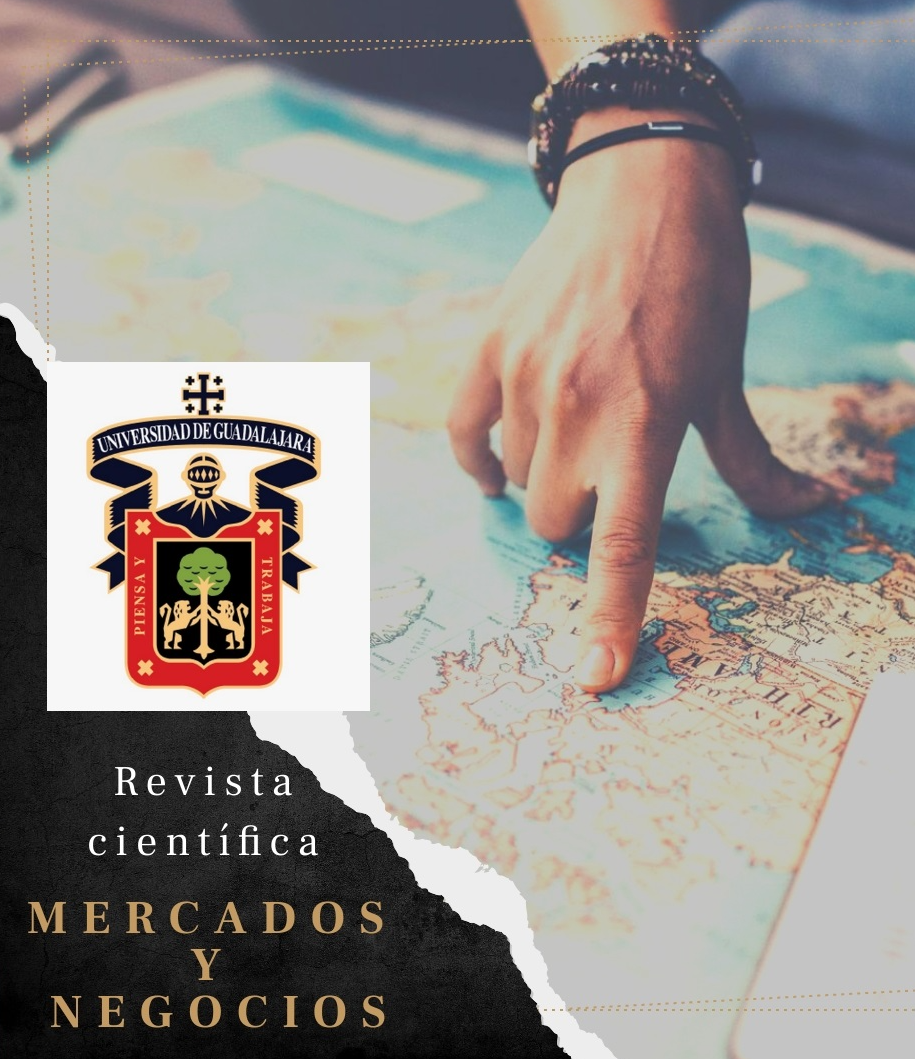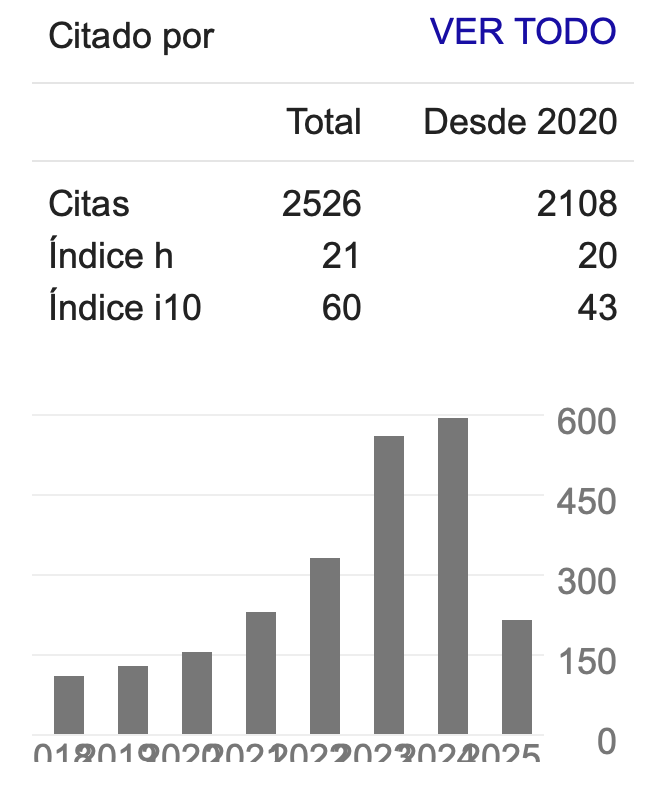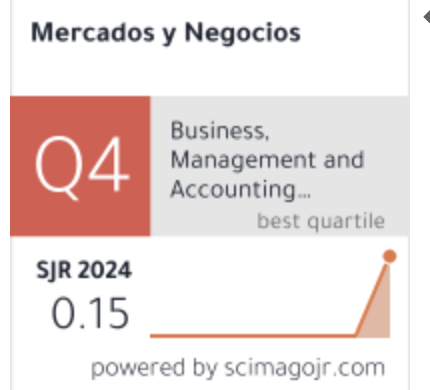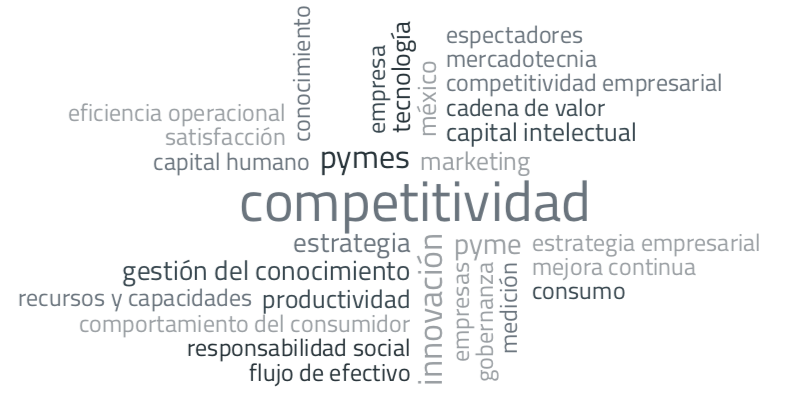eWOM y toma de decisiones del consumidor en el mercado hotelero: análisis bibliométrico
DOI:
https://doi.org/10.32870/myn.v1i42.7559Keywords:
eWOM, proceso de toma de decisiones del consumidor, bibliometría, word-of-mouth electrónicoAbstract
El objetivo principal de este artículo es establecer las relaciones bibliométricas entre los términos: eWOM y Proceso de decisión de compra del consumidor, así como sus tendencias y principales indicadores y dimensiones estudiadas en la última década. Se mapeó el desarrollo del área de investigación en términos de la frecuencia de publicaciones y sus citaciones, las revistas o journals y la dispersión geográfica. Se encontró que la relación eWOM y toma de decisiones del consumidor tiene una tendencia creciente hasta 2017, después decrecre y poco se trabajó antes de 2009.References
Aggarwal, R., Gopal, R., Gupta, A., & Singh, H. (2012). Putting money where the mouths are: The relation between venture financing and electronic Word-of-Mouth. Information Systems Research, 23(3 PART 2), 976–992. https://doi.org/10.1287/isre.1110.0402
Alhidari, A., Iyer, P., & Paswan, A. (2015). Personal level antecedents of eWOM and purchase intention, on social networking sites. Journal of Customer Behaviour, 14(2), 107–125. https://doi.org/10.1362/147539215x14373846805707
Ardanuy, J., & Rey, L. (2009). Breve introducción a la bibliometría. Universitat de Barcelona, 63. https://doi.org/10.1038/nmat3485
Ashman, R., Solomon, M. R., & Wolny, J. (2015). An old model for a new age: Consumer decision making in participatory digital culture. Journal of Customer Behaviour, 14(2), 127–146. https://doi.org/10.1362/147539215x14373846805743
Baker, A. M., Donthu, N., & Kumar, V. (2016). Investigating How Word-of-Mouth Conversations About Brands Influence Purchase and Retransmission Intentions. Journal of Marketing Research, 53(2), 225–239. https://doi.org/10.1509/jmr.14.0099
Balakrishnan, B. K. P. D., Dahnil, M. I., & Yi, W. J. (2014). The Impact of Social Media Marketing Medium toward Purchase Intention and Brand Loyalty among Generation Y. Procedia - Social and Behavioral Sciences, 148, 177–185. https://doi.org/10.1016/j.sbspro.2014.07.032
Brem, A., & Bilgram, V. (2015). The search for innovative partners in co-creation: Identifying lead users in social media through netnography and crowdsourcing. Journal of Engineering and Technology Management, 37, 40–51. https://doi.org/10.1016/j.jengtecman.2015.08.004
Cheng, X., & Zhou, M. (2010). Study on Effect of eWOM: a Literature Review and Suggetions for Future Research.
Chevalier, J., & Mayzlin, D. (2004). The effect of word-of-mouth on sales: online book reviews. Journal of Marketing Research. https://doi.org/10.1509/jmkr.43.3.345
Craig, C. S., Greene, W. H., & Versaci, A. (2015). E-Word of Mouth: Early Predictor Of Audience Engagement. Journal of Advertising Research, 55(1), 62–72. https://doi.org/10.2501/jar-55-1-062-072
Dellarocas, C. (2006). Strategic Manipulation of Internet Opinion Forums: Implications for Consumers and Firms. Management Science, 52(10), 1577–1593. https://doi.org/10.1287/mnsc.1060.0567
Dellarocas, C., Zhang, X., Awad, N. F., & Zhang, X. (2007). Exploring the value of online product reviews in forecasting sales: The case of motion pictures. En Journal of Interactive Marketing (Vol. 21, pp. 23–45). https://doi.org/10.1002/dir.20087
Elsevier. (2019). Acerca de SCOPUS. Elsevier. Loink: https://www.elsevier.com/es-mx/solutions/scopus
Engel, J. F., Kegerreis, R. J., & Blackwell, R. D. (1969). Word-of-Mouth Communication by the Innovator. Journal of Marketing, 33(3), 15. https://doi.org/10.2307/1248475
Fagerberg, J., Fosaas, M., & Sapprasert, K. (2012). Innovation: Exploring the knowledge base. Research Policy, 41(7), 1132–1153. https://doi.org/10.1016/j.respol.2012.03.008
Fujimoto, K. (2012). Investigation of Potency-magnitude Relations of eWOM Messages with a Focus on the Distinction between Attitude Direction and Strength (pp. 69–73). https://doi.org/10.1109/wi-iat.2012.34
GitHub. (2017). About - Voyant Tools Help. Recuperado el 6 de junio de 2017, de http://voyant-tools.org/
Glasgow, S., Bore, I., Antony, J., Rutherford, C., & Taheri, B. (2017). A systematic literature review on eWOM in the hotel industry: Current trends and suggestions for future research. Hospitality & Society, 7(1), 63–85. https://doi.org/10.1386/hosp.7.1.63_1
Goodrich, K., & de Mooij, M. (2014). How “social” are social media? A cross-cultural comparison of online and offline purchase decision influences. Journal of Marketing Communications, 20(1–2), 103–116. https://doi.org/10.1080/13527266.2013.797773
Gruen, T. W., Osmonbekov, T., & Czaplewski, A. J. (2006). eWOM: The impact of customer-to-customer online know-how exchange on customer value and loyalty. Journal of Business Research, 59(4), 449–456. https://doi.org/10.1016/j.jbusres.2005.10.004
Hennig-Thurau, T., Gwinner, K. P., Walsh, G., & Gremler, D. D. (2004). Electronic word-of-mouth via consumer-opinion platforms: What motivates consumers to articulate themselves on the Internet? Journal of Interactive Marketing, 18(1), 38–52. https://doi.org/10.1002/dir.10073
Hernández, J., Muñoz, F., & Sánchez, J. (2015). The influence of e-word-of-mouth on travel decision-making: consumer profiles. Current Issues in Tourism, 18(11), 1001–1021. https://doi.org/10.1080/13683500.2013.802764
Homburg, C., Ehm, L., & Artz, M. (2015). Measuring and Managing Consumer Sentiment in an Online Community Environment. Journal of Marketing Research, 52(5), 629–641. https://doi.org/10.1509/jmr.11.0448
Hsu, C.-L., Lin, J. C.-C., & Chiang, H.-S. (2013). The effects of blogger recommendations on customers’ online shopping intentions. Internet Research, 23(1), 69–88. https://doi.org/10.1108/10662241311295782
Hussain, S., Ahmed, W., Jafar, R. M. S., Rabnawaz, A., & Jianzhou, Y. (2017). eWOM source credibility, perceived risk and food product customer’s information adoption. Computers in Human Behavior, 66, 96–102. https://doi.org/10.1016/j.chb.2016.09.034
Jimmy Xie, H., Miao, L., Kuo, P.-J., & Lee, B.-Y. (2011). Consumers’ responses to ambivalent online hotel reviews: The role of perceived source credibility and pre-decisional disposition. International Journal of Hospitality Management, 30(1), 178–183. https://doi.org/10.1016/j.ijhm.2010.04.008
Kim, S., Martinez, B., McClure, C., & Kim, S. H. (2016). eWOM Intentions toward Social Media Messages. Atlantic Marketing Journal, 5(1).
King, R. A., Racherla, P., & Bush, V. D. (2014). What We Know and Don’t Know About Online Word-of-Mouth: A Review and Synthesis of the Literature. Journal of Interactive Marketing, 28(3), 167–183. https://doi.org/10.1016/j.intmar.2014.02.001
Ladhari, R., & Michaud, M. (2015). eWOM effects on hotel booking intentions, attitudes, trust, and website perceptions. International Journal of Hospitality Management, 46, 36–45. https://doi.org/10.1016/j.ijhm.2015.01.010
López, M., & Sicilia, M. (2014). Determinants of E-WOM influence: The role of consumers’ internet experience. Journal of Theoretical and Applied Electronic Commerce Research, 9(1), 28–43. https://doi.org/10.4067/S0718-18762014000100004
Luo, Q., & Zhong, D. (2015). Using social network analysis to explain communication characteristics of travel-related electronic word-of-mouth on social networking sites. Tourism Management, 46, 274–282. https://doi.org/10.1016/j.tourman.2014.07.007
Mauri, A. G., & Minazzi, R. (2013). Web reviews influence on expectations and purchasing intentions of hotel potential customers. International Journal of Hospitality Management, 34, 99–107. https://doi.org/10.1016/j.ijhm.2013.02.012
Pan, L.-Y., & Chiou, J.-S. (2011). How Much Can You Trust Online Information? Cues for Perceived Trustworthiness of Consumer-generated Online Information. Journal of Interactive Marketing, 25(2), 67–74. https://doi.org/10.1016/j.intmar.2011.01.002
Pinar, I. S., Rey, U., Carlos, J., José, M., Costa, P., Rey, U., & Carlos, J. (2012). Análisis Bibliométrico Del Corporate Entrepeneurship : Indicadores De La Producción Científica. Universidad Rey Juan Carlos.
Portugal, M., Ribeiro, F., Kramer, B., & Almeida, M. (2016). A bibliometric study of the RBV in international business research using Barney (1991) as a key marker. Revista Innovar Journal Revista de Ciencias Administrativas y Sociales, 26(61), 131. https://doi.org/10.15446/innovar.v26n61.57173
Riquelme, I. P., Román, S., & Iacobucci, D. (2016). Consumers’ Perceptions of Online and Offline Retailer Deception: A Moderated Mediation Analysis. Journal of Interactive Marketing, 35, 16–26. https://doi.org/10.1016/j.intmar.2016.01.002
Rong, J., Vu, H. Q., Law, R., & Li, G. (2012). A behavioral analysis of web sharers and browsers in Hong Kong using targeted association rule mining. Tourism Management, 33(4), 731–740. https://doi.org/10.1016/j.tourman.2011.08.006
Sinclair, S., & Rockwell, G. (2015). Text Analysis and Visualization. A New Companion to Digital Humanities, 274–290. https://doi.org/10.1002/9781118680605.ch19
Spaulding, T. J. (2010). How can virtual communities create value for business? Electronic Commerce Research and Applications, 9(1), 38–49. https://doi.org/10.1016/j.elerap.2009.07.004
Steffes, E. M., & Burgee, L. E. (2009). Social ties and online word of mouth. Internet Research, 19(1), 42–59. https://doi.org/10.1108/10662240910927812
Tham, A., Croy, G., & Mair, J. (2013). Social Media in Destination Choice: Distinctive Electronic Word-of-Mouth Dimensions. Journal of Travel and Tourism Marketing, 30(1–2), 144–155. https://doi.org/10.1080/10548408.2013.751272
Thies, F., Wessel, M., & Benlian, A. (2016). Effects of Social Interaction Dynamics on Platforms. Journal of Management Information Systems, 33(3), 843–873. https://doi.org/10.1080/07421222.2016.1243967
Tsao, W.-C., Hsieh, M.-T., Shih, L.-W., & Lin, T. M. Y. (2015). Compliance with eWOM: The influence of hotel reviews on booking intention from the perspective of consumer conformity. International Journal of Hospitality Management, 46, 99–111. https://doi.org/10.1016/j.ijhm.2015.01.008
Viglia, G., Minazzi, R., & Buhalis, D. (2016). The influence of e-word-of-mouth on hotel occupancy rate. International Journal of Contemporary Hospitality Management, 28(9), 2035–2051. https://doi.org/10.1108/IJCHM-05-2015-0238
Wu, Y., & Wu, J. (2016). The Impact of User Review Volume on Consumers’ Willingness-to-Pay: A Consumer Uncertainty Perspective. Journal of Interactive Marketing, 33, 43–56. https://doi.org/10.1016/j.intmar.2015.11.001
Xie, H., Miao, L., Kuo, P.-J., & Lee, B.-Y. (2011). Consumers’ responses to ambivalent online hotel reviews: The role of perceived source credibility and pre-decisional disposition. International Journal of Hospitality Management, 30(1), 178–183. https://doi.org/10.1016/j.ijhm.2010.04.008
Xu, Q. (2014). Should i trust him? the effects of reviewer profile characteristics on eWOM credibility. Computers in Human Behavior, 33, 136–144. https://doi.org/10.1016/j.chb.2014.01.027
Yang, Y., Wang, C.-C., & Lai, M.-C. (2014). Using Bibliometric Analysis to Explore Research Trend of Electronic Word-of-Mouth from 1999 to 2011. International Journal of Innovation, Management and Technology, 3(4). https://doi.org/10.7763/ijimt.2012.v3.250
Yen, C.-L., & Tang, C.-H. (2015). Hotel attribute performance, eWOM motivations, and media choice. International Journal of Hospitality Management, 46, 79–88. https://doi.org/10.1016/j.ijhm.2015.01.003
You, Y., Vadakkepatt, G. G., & Joshi, A. M. (2015). A Meta-Analysis of Electronic Word-of-Mouth Elasticity. Journal of Marketing, 79(2), 19–39. https://doi.org/10.1509/jm.14.0169
Zhang, K. Z. K., Zhao, S. J., Cheung, C. M. K., & Lee, M. K. O. (2014). Examining the influence of online reviews on consumers’ decision-making: A heuristic–systematic model. Decision Support Systems, 67, 78–89. https://doi.org/10.1016/j.dss.2014.08.005
Published
How to Cite
Issue
Section
License
Mercados y Negocios by Department of Mercadotecnia y Negocios Internacionales. University of Guadalajara is licensed under a License Creative Commons Attribution-NonCommercial 4.0 International.
The author retains the copyright.








